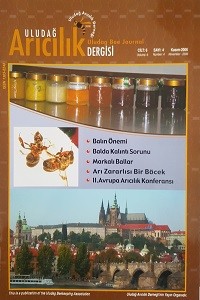Abstract
Bu çalışmada, ülkemizde üretilen ballarda antibiyotik kalıntısı durumunun incelenmesi hedeflenmiştir. 2006 yılının ilk altı ayı içerisinde 22 farklı yöreden direkt arıcılardan toplanan numuneler üzerinde tetrasiklin, streptomisin ve sulfa grubu antibiyotiklerin kalıntıları araştırılmıştır. Analizler, ELISA ve yüksek performanslı sıvı kromatografi (HPLC) yöntemleri ile gerçekleştirilmiştir. Sonuç olarak arıcıların %10-15’inin yasal olmamasına karşın halen, yavru çürüklüğü hastalığına karşı bu antibiyotikleri içeren ilaçlar kullandığı tespit edilmiştir. Kalıntı sorunu yörelere göre incelendiğinde sulfa ve tetra grubu antibiyotik kalıntılarının Muş, Bingöl, Şemdinli, Yüksekova bölgelerinde ve Marmaris Muğla bölgesinde yoğunlaştığı belirlenmiştir
Keywords
References
- 2001/700/ECC, 2001. Commission decision of 17 september 2001 amending decision 94/278/EC drawing up a list of third countries from which member states authorise imports of certain products to council directive 92/118/EEC, with respect to imports of honey, European Community Council, Bruxelles.
- 2377/90/ECC, 1990. Council regulation (EEC) No: of 26 June decision of 1990 laying down a comminity procedure for the establishment of maximum residue limits of veterinary medicinal products in foodstufs of animal origin, European Community Council, Bruxelles.
- AOAC 920.180, 2000. Official Method: Honey (Liquid, strained or comb) preparation of test sample, AOAC International 17th edition, Gaithersburg. Doğaroğlu, M. ve Samancı, T., 2006. Balda yörelere göre kalıntı hile ve orijin tespit projesi, Teknoloji ve Yenilik Destek Programları Başkanlığı (TEYDEB) arıcılık raporu, Ankara, Türkiye. Filodda, F., Kirsch, R.,Smidt, J.,Tuchel,P., 2002. “Use of antibiotics in the production of honey–Risks and perspectives for the honey importers and honey indutry”, Preventing Residues in Honey. APIMONDIA Symposium. 10–11. Oct. Celle. Germany. Martin, P. Chem,C., Chem,M.A. 2002. “Imports into the EU from third countries, veterinary and other requirements”, European Federation of Honey Packers and Distributors. Third Caribbean Beekeeping Congress.
- Martin, P., 2002. “Veterinary Drug Residues in Honey”, Preventing Residues in Honey. APIMONDIA Symposium. 10–11. Oct. Celle. Germany.
- Öztürk, A.İ., 2001. Arıcılık, Tarım ve Köyişleri Bakanlığı Teşkilatlanma ve Destekleme Genel Müdürlüğü, Ankara.
- Sunay, A., Altıparmak Ö., Doğaroğlu M. ve Gökçen J., 2004. Türkiye’de ve Dünyada bal üretimi, ticareti ve karşılaşılan sorunlar, içindedir II. Marmara Arıcılık Kongresi Bildiri Kitabı, pp.151-183, Eds. Aydın, L., Çakmak, İ. ve Güneş, N., Uludağ Üniversitesi Basımevi, Bursa.
- Türk Gıda Kodeksi 2005/49, 2005. Türk Gıda Kodeksi-Bal Tebliği, Resmi Gazete 26026, Ankara.
- Türk Gıda Kodeksi, 2002/30, 2002. Hayvansal Kökenli Gıdalarda Veteriner İlaçları Maksimum Kalıntı Limitleri Tebliği, Resmi Gazete 24739, Ankara.
Abstract
The aim of this study is to determine the situation about antibiotic residues in Turkish honey. For this purpose, honey samples were collected from beekeepers from 22 different regions in Turkey. The samples were analyzed for residues of sulfonamides, tetracyclines and streptomycin group antibiotics which are not legally permitted to be used for beekeeping in Turkey. ELISA and high performance liquid chromatographic techniques were used for analyzing the compounds. Results showed that %10-15 of the beekeepers, are still using those antibiotics against foulbrood diseases. When the results are examined according to the geographical regions, residues of sulfo and tetra group antibiotics are mostly found in honey from Muş, Bingöl, Şemdinli, Yüksekova and Marmaris Muğla districts.
Key Words: Honey, antibiotics, beekeeping, honey analysis, residues,
Keywords
References
- 2001/700/ECC, 2001. Commission decision of 17 september 2001 amending decision 94/278/EC drawing up a list of third countries from which member states authorise imports of certain products to council directive 92/118/EEC, with respect to imports of honey, European Community Council, Bruxelles.
- 2377/90/ECC, 1990. Council regulation (EEC) No: of 26 June decision of 1990 laying down a comminity procedure for the establishment of maximum residue limits of veterinary medicinal products in foodstufs of animal origin, European Community Council, Bruxelles.
- AOAC 920.180, 2000. Official Method: Honey (Liquid, strained or comb) preparation of test sample, AOAC International 17th edition, Gaithersburg. Doğaroğlu, M. ve Samancı, T., 2006. Balda yörelere göre kalıntı hile ve orijin tespit projesi, Teknoloji ve Yenilik Destek Programları Başkanlığı (TEYDEB) arıcılık raporu, Ankara, Türkiye. Filodda, F., Kirsch, R.,Smidt, J.,Tuchel,P., 2002. “Use of antibiotics in the production of honey–Risks and perspectives for the honey importers and honey indutry”, Preventing Residues in Honey. APIMONDIA Symposium. 10–11. Oct. Celle. Germany. Martin, P. Chem,C., Chem,M.A. 2002. “Imports into the EU from third countries, veterinary and other requirements”, European Federation of Honey Packers and Distributors. Third Caribbean Beekeeping Congress.
- Martin, P., 2002. “Veterinary Drug Residues in Honey”, Preventing Residues in Honey. APIMONDIA Symposium. 10–11. Oct. Celle. Germany.
- Öztürk, A.İ., 2001. Arıcılık, Tarım ve Köyişleri Bakanlığı Teşkilatlanma ve Destekleme Genel Müdürlüğü, Ankara.
- Sunay, A., Altıparmak Ö., Doğaroğlu M. ve Gökçen J., 2004. Türkiye’de ve Dünyada bal üretimi, ticareti ve karşılaşılan sorunlar, içindedir II. Marmara Arıcılık Kongresi Bildiri Kitabı, pp.151-183, Eds. Aydın, L., Çakmak, İ. ve Güneş, N., Uludağ Üniversitesi Basımevi, Bursa.
- Türk Gıda Kodeksi 2005/49, 2005. Türk Gıda Kodeksi-Bal Tebliği, Resmi Gazete 26026, Ankara.
- Türk Gıda Kodeksi, 2002/30, 2002. Hayvansal Kökenli Gıdalarda Veteriner İlaçları Maksimum Kalıntı Limitleri Tebliği, Resmi Gazete 24739, Ankara.
Details
| Primary Language | Turkish |
|---|---|
| Subjects | Structural Biology |
| Journal Section | Research Articles |
| Authors | |
| Publication Date | November 27, 2006 |
| Published in Issue | Year 2006 Volume: 06 Issue: 4 |
Important Note: Since the author-referee information is kept confidential on both sides in our journal, both the author and the referees must upload the document to the system after removing their personal information in the review document section.
Note: Authors can also use homepage of our Journal.
https://creativecommons.org/licenses/by-nc-nd/4.0/
This work is licensed under Attribution-NonCommercial-NoDerivatives 4.0 International.


